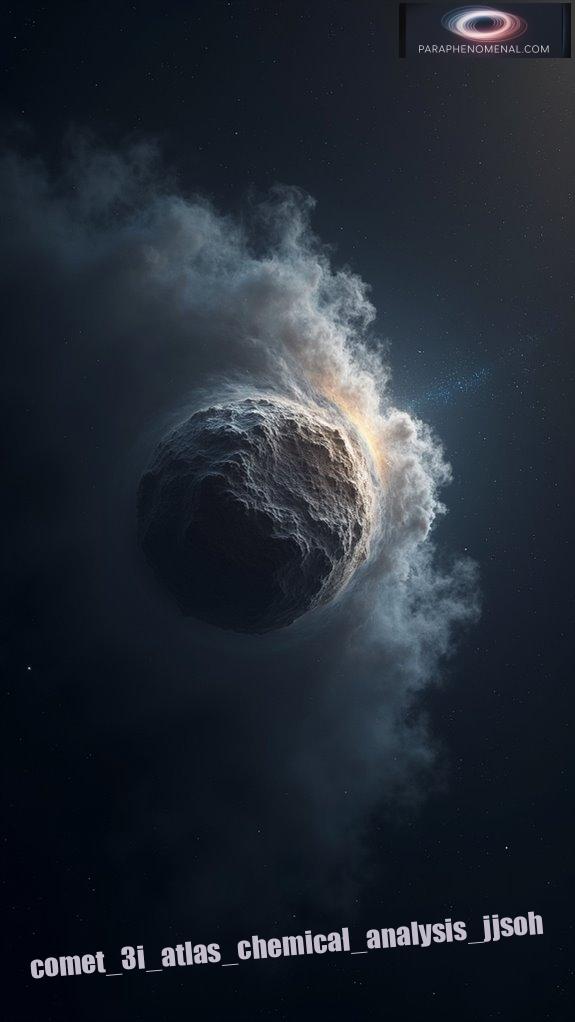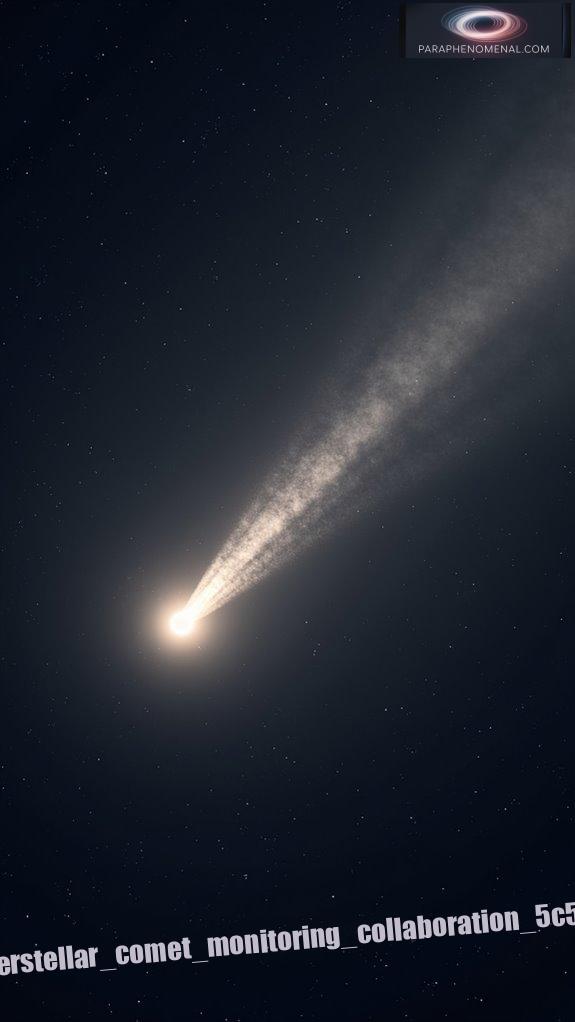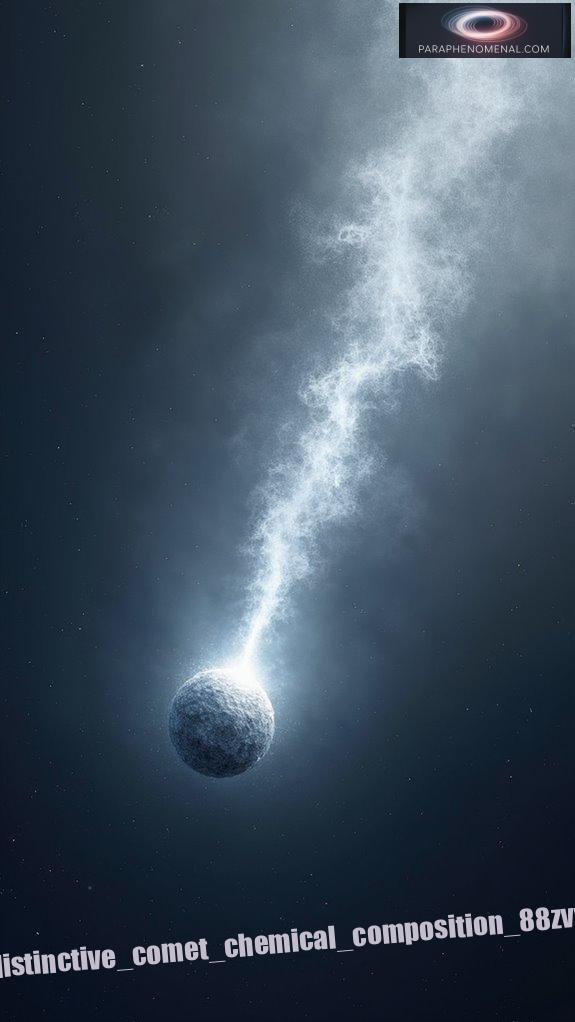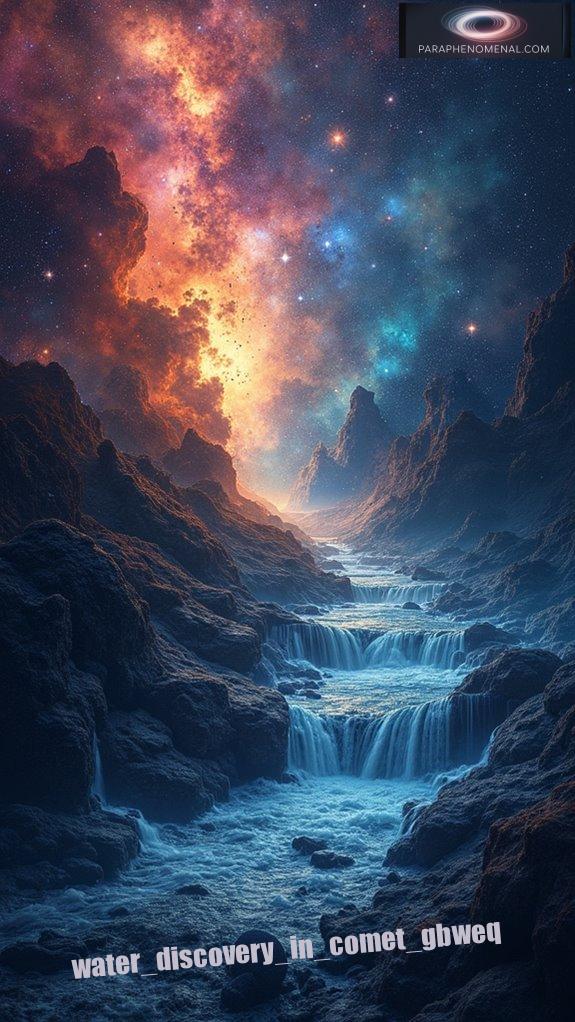Did you hear about NASA’s latest find?
Water vapor in comet 3I/ATLAS—what a tantalizing discovery!
As I learned about its unusual carbon dioxide-to-water ratio, I couldn’t help but wonder: could this be a cosmic clue to extraterrestrial life?
This comet isn’t just floating around; it’s from interstellar space! Imagine all the mysteries it might hold about life beyond Earth.
Could comets be the ultimate interstellar delivery system for the building blocks of life? It certainly invites more exploration and discussion.
Quick Takeaways
- NASA’s discovery of water vapor in comet 3I/ATLAS suggests the potential for life-essential ingredients found in space.
- The unique CO₂-to-H₂O ratio of 8:1 indicates the comet’s formation near the CO₂ frost line.
- 3I/ATLAS demonstrates rapid water release, supporting the idea of comets transporting life’s building blocks across the galaxy.
- The detection of organic compounds in interstellar comets like 3I/ATLAS could seed habitable environments on distant planets.
- Observations with innovative techniques enhance our understanding of comet dynamics and the chemical diversity in the universe.
Water Vapor Detection: A Surprising Discovery

As NASA’s Neil Gehrels Swift Observatory made its surprising discovery of water vapor in the comet 3I/ATLAS, it opened new avenues for understanding cosmic bodies beyond our Solar System.
The water detection resulted from identifying hydroxyl (OH), a byproduct of water photodissociation, using Swift’s 30cm telescope. This method allowed researchers to catch faint ultraviolet signals from the comet, even when it was nearly three times farther from the Sun than Earth.
These unexpected findings challenged conventional ideas about comet activity, as 3I/ATLAS released water vapor at a substantial rate far from the typical sublimation distance. This discovery showcases the potential for uncovering the ingredients for life and fosters explorations that inspired us to create ParaPhenomenal, focusing on cosmic phenomena beyond our immediate understanding. Additionally, the fact that 3I/ATLAS is likely the oldest comet reveals that our understanding of the origins of celestial bodies may be significantly revised.
Characteristics of Interstellar Comet 3I/ATLAS
Interstellar comet 3I/ATLAS stands out due to its unique characteristics that offer understanding about its origins and behavior. Its strongly hyperbolic orbit, with an eccentricity of approximately 6.08, confirms its interstellar origins. Additionally, recent observations suggest the comet exhibits significant dust mass-loss rate, calculated at approximately ∼0.11-1.0 kg/s, indicative of its active nature. Scientists have been particularly interested in the dust ejection processes as they can reveal more about the comet’s composition and behavior.
Here’s a brief summary:
| Feature | Description |
|---|---|
| Velocity at Infinity | ~57 km/s |
| Closest Approach to Earth | 1.8 AU, allowing safe observation |
| Coma Cross-Section | ~230 km² |
Trajectory analysis reveals that 3I/ATLAS isn’t bound to the Solar System—it will move away indefinitely after perihelion. Additionally, the morphology of its teardrop-shaped dust coma shows ongoing dust ejection, emphasizing its dynamic nature and providing understanding about its distant origins.
Chemical Composition: Insights From Analysis

Understanding the chemical composition of comet 3I/ATLAS reveals fascinating observations about its origins and behavior.
The dominance of carbon dioxide in its coma, with a CO₂-to-water ratio of 8:1, stands out as a significant chemical anomaly. This high ratio indicates that 3I/ATLAS might’ve formed near the CO₂ frost line, influencing its dust evolution. Recent studies indicate that interstellar comets possess unique chemical signatures that could provide insight into the building blocks of life.
Water has been detected but in much lower abundance than CO₂, likely resulting from CO₂-driven activity at greater distances from the Sun.
In addition, its unique dust composition—95% carbon dioxide and 5% water—suggests uncommon evolutionary processes and preservation of primordial materials. Interestingly, the comet has been classified as an interstellar object due to its hyperbolic orbit, which has implications for its formation and journey through the galaxy.
Continued analysis may uncover more about these distinctive characteristics, enriching our understanding of comets.
Implications for Astrobiology and the Search for Life
With the detection of water vapor from comet 3I/ATLAS, scientists believe this finding opens new avenues in astrobiology and the hunt for extraterrestrial life. This discovery suggests that cosmic water and the ingredients essential for life may be found widely across the galaxy, challenging prior assumptions about interstellar biology. The rapid water release indicates that such comets can harbor life’s building blocks and possibly transport them between star systems. This could seed habitable environments with crucial organic molecules. As we explore these implications, we enhance our understanding of how fundamental chemistry evolves in diverse stellar settings.
The water release from 3I/ATLAS at an impressive 40 kg per second highlights the potential of these celestial bodies to contribute significantly to the building blocks of life. Recent studies indicate that these comets may also be sources of organic compounds, enhancing the prospects for life’s emergence on distant planets. At ParaPhenomenal, we aim to unravel these cosmic mysteries, bringing you closer to the truth about life beyond Earth.
Monitoring 3I/ATLAS: A Unique Opportunity

As scientists monitor 3I/ATLAS, they find themselves facing a remarkable opportunity to study an interstellar object up close. The interstellar nature of 3I/ATLAS provides a unique perspective into cometary dynamics, allowing for innovative observational techniques. In fact, the discovery of such interstellar objects enhances our understanding of the diversity of celestial bodies beyond our solar system.
| Key Observations | Notable Techniques |
|---|---|
| Brightness Increases | Image Stacking |
| Sublimation of Compounds | Multi-Wavelength Campaign |
| Chemical Composition | Data Analysis Across Facilities |
Tracking this comet requires collaboration across global observatories, enhancing our understanding of its volatile behavior. During its closest approach, researchers will utilize vast data sources, leveraging tools like the UNISTELLAR Network. These efforts reinforce why we created ParaPhenomenal, to foster engagement in discoveries beyond our world.
Open Questions About Water Release Mechanisms
The unique findings from monitoring 3I/ATLAS have opened several intriguing questions about how it releases water.
Understanding the sublimation dynamics in this comet is essential, as it ejects water at an astonishing rate of around 40 kg/s. It seems that icy debris, not the nucleus itself, drives this process.
These “miniature steam vents” heat up in sunlight, contributing noticeably to water release, with at least 8% surface activity compared to typical comets.
Another mystery lies in the interactions of CO2 within the release mechanism. Does it suppress water sublimation, or is the nucleus wrapped in an insulating crust? Notably, sublimation dynamics play a critical role in the efficiency of water release from such celestial bodies.
Exploring these open questions can shed light on the volatile release physics in interstellar comets, fueling our continuing curiosity at ParaPhenomenal.
Unraveling the Mystery of Cosmic Composition

NASA’s recent observations of 3I/ATLAS disclose a distinctive chemical composition that sets it apart from typical comets in our Solar System. This comet showcases unique properties, providing glimpses into cosmic radiation and the complexities of interstellar formation.
| Composition | Ratio | Implications |
|---|---|---|
| CO₂-to-H₂O | 8.0±1.0 | Suggests volatile origins |
| CO-to-H₂O | 1.4±0.2 | Reflects cosmic diversity |
| Spectral Analysis | JWST Data | Reveals cometary dynamics |
The high CO₂ presence hints at unusual solar interaction and challenges our understanding of typical comets. Such detailed spectral analysis promotes inquiries into the origins of life beyond Earth, adding an enticing layer to the mystery of cosmic compositions while aligning with our mission at ParaPhenomenal to explore the unknown.
FAQ
How Did Scientists First Discover Comet 3i/Atlas?
Envision you’re stargazing, then boom – scientists discover comet 3I/ATLAS through collaborative observations. They identified its trajectory and eccentric orbit, linking it to interstellar origins, showcasing the beauty of comet formation and teamwork.
What Are the Future Observation Plans for Comet 3i/Atlas?
In the future, you’ll use advanced observational techniques to study 3I/ATLAS as it approaches Jupiter. These revelations may inspire future missions, helping you uncover its mysteries and potential links to life beyond Earth.
How Do Other Interstellar Comets Compare to 3i/Atlas?
When comparing interstellar comets, you’ll find 3I/ATLAS stands out with its unique interstellar composition and cometary activity. Unlike ‘Oumuamua’s dryness, it exhibits rich emissions, hinting at a lively past beyond our solar system.
What Tools Were Used to Observe the Water Vapor?
You’ll find that spectroscopic techniques and infrared imaging were key tools in observing the water vapor. These methods helped capture faint signals and confirm the presence of water molecules in the comet’s coma.
Are There Potential Risks to Spacecraft Monitoring 3i/Atlas?
Yes, you face significant risks monitoring 3I/ATLAS. Intense radiation exposure can cause spacecraft damage, while its high velocity complicates navigation, risking data loss and sensor degradation during unpredictable comet activity and environmental changes.
References
- https://www.astronomy.com/science/comet-3i-atlas-reaches-perihelion-begins-solar-transit/
- https://www.space.com/astronomy/comets/awakening-an-interstellar-wanderer-surprising-nickel-detection-in-comet-3i-atlas
- https://www.livescience.com/space/comets/comet-3i-atlas-has-been-transformed-by-billions-of-years-of-space-radiation-james-webb-space-telescope-observations-reveal
- https://www.space.com/astronomy/comets/interstellar-invader-comet-3i-atlas-is-still-full-of-surprises-an-unexpected-brightening-has-scientists-baffled
- https://www.youtube.com/watch?v=ZtQHgCEVZ4o
- https://www.skyatnightmagazine.com/news/3i-atlas-neil-gehrels-swift-water-detection
- https://www.livescience.com/space/comets/comet-3i-atlas-is-losing-water-like-a-fire-hose-on-full-blast-rewriting-what-we-thought-we-knew-about-alien-star-systems
- https://astrobiology.com/2025/07/interstellar-comet-3i-atlas-discovery-and-physical-description.html
- https://arxiv.org/abs/2507.05252
- https://en.wikipedia.org/wiki/3I/ATLAS
- https://ui.adsabs.harvard.edu/abs/2025MNRAS.542L.139B/abstract
- https://skyandtelescope.org/astronomy-blogs/explore-night-bob-king/all-eyes-on-interstellar-comet-3i-atlas/
- https://science.nasa.gov/solar-system/comets/3i-atlas/
- https://cosmicpursuits.com/3880/a-visitor-from-beyond-comet-3i-atlas-rounds-the-sun/
- https://phys.org/news/2025-10-rapid-brightening-interstellar-comet-3iatlas.html
- https://science.nasa.gov/missions/hubble/as-nasa-missions-study-interstellar-comet-hubble-makes-size-estimate/
- https://www.nextbigfuture.com/2025/08/interstellar-3i-atlas-has-nickel-without-iron-and-other-chemical-makeup-that-is-unlike-natural-objects-in-the-solar-system.html
- https://thedebrief.org/3i-atlas-is-displaying-surprising-new-activity-that-scientists-liken-to-a-note-from-another-planetary-system/
- https://astrobiology.com/2025/10/astrochemistry-physicists-uncork-a-message-in-a-bottle-from-another-star.html
- https://www.space.com/astronomy/comets/interstellar-comet-3i-atlas-is-leaking-water-like-a-fire-hose-running-at-full-blast-new-study-finds
- https://astrobiology.com/2025/08/water-detection-in-the-interstellar-object-3i-atlas.html
- https://futurism.com/space/interstellar-object-spraying-water
- https://www.youtube.com/watch?v=j-S3UgLWZDM
- https://www.space.com/astronomy/comets/interstellar-comet-3i-atlas-could-help-protect-earth-from-dangerous-asteroids-heres-how
- https://www.seti.org/news/comet-3iatlas-a-visitor-from-beyond-the-solar-system/
- https://science.nasa.gov/blogs/planetary-defense/2025/07/02/nasa-discovers-interstellar-comet-moving-through-solar-system/
- https://science.nasa.gov/solar-system/comets/3i-atlas/comet-3i-atlas-multimedia/
- https://arxiv.org/html/2508.04675v1
- https://www.spectroscopyonline.com/view/interstellar-comet-3i-atlas-shows-its-spectral-secrets-through-palomar-and-apache-point-observations
- https://www.youtube.com/watch?v=hZWKAxFeNp8
